Aloe vera plants are easier to care for than most people think, and they can grow very well both indoors and outside.
The key is to neglect your plant. Yes, that’s right, just ignore it. Well, you can’t ignore it forever, but the biggest mistake people make is giving it too much attention. This usually results in what I call “killing it with kindness”.
In this detailed guide, I will show you all you need to know: from water, light, and soil, to pest control, fertilizer, and much more.
Quick Aloe Vera Care Overview
| Scientific name: | Aloe vera |
| Classification: | Succulent plant |
| Common names: | Medicinal Aloe |
| Hardiness: | Zones 9-11 |
| Temperature: | 60-85°F |
| Flowers: | Yellow, can bloom year round |
| Light: | Full sun to partial shade |
| Water: | Allow soil to dry out, do not overwater |
| Humidity: | Little to none |
| Fertilizer: | General purpose plant food in spring and summer |
| Soil: | Fast-draining, sandy or gritty soil |
| Common pests: | Mealybugs, scale |
Information About Aloe Vera Plants
Aloe vera, or medicinal aloe, is best known for the healing qualities of the gel. It is very common, and just one of hundreds of different species in the Aloe genus of plants.
This popular succulent is a perennial that’s native to the Arabian Peninsula, but these days it is grown all over the world. If you live in a warm enough climate you can plant it in your garden, otherwise it makes a great houseplant.
Whether you want to grow it for the medicinal benefits, or you simply love the look of the spiky leaves, it’s definitely one that you’ll be able to enjoy for many years to come. My aloe vera plant is over 20 years old, and it’s still growing strong.
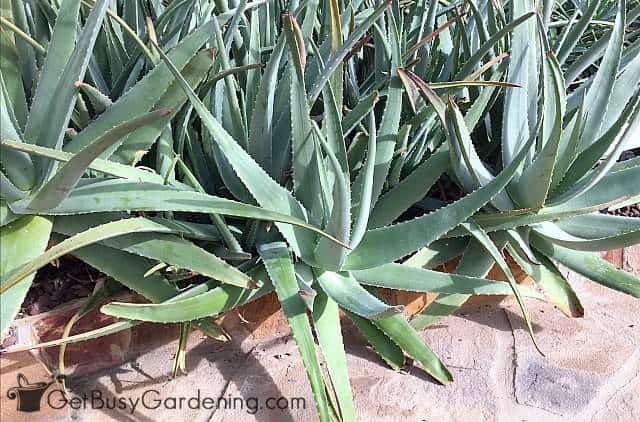
Aloe Vera Plant Benefits
Most people are already very familiar with the medicinal and healing qualities of aloe vera plants. The gel is used in everything from skin and hair care items, to drinks, supplements, and food products.
You can harvest the leaves and gel from your plant and apply it to relieve minor burns and cuts. Or use it to make your own soaps, lotions, and other skin care products if you want.
Another great benefit that many people don’t know about is that growing aloe vera indoors helps to purify the air in your home.
Related Post: How To Store Aloe Vera (Leaves Or Gel)
Where To Grow Aloe Vera
Whether you grow your aloe vera indoors or outside depends on where you live. But either way, choosing the right location is important for them to thrive.
Hardiness
Aloe vera plants are hardy down to zone 9a, and grow best in arid climates. Though they can handle short bursts of freezing temps, they will eventually die if it stays cold for too long.
If you live in a cooler region, or someplace tropical where it rains a lot, then you must move yours indoors during the winter or wet months.
Location
The best location to grow an aloe vera plant is somewhere sunny and dry. Outdoors, plant it in a spot where the soil is very sandy and well-draining. Indoors place your potted plant in a bright, south-facing window.
Though you could keep it inside year-round, you can put it outside during the hot and sunny months. Just make sure the pot has drainage holes, and bring it back indoors before it drops below 60°F in the fall.
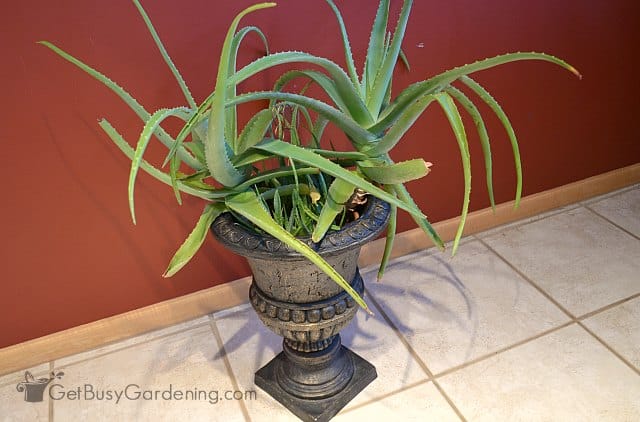
Aloe Vera Plant Care & Growing Instructions
The good news is that aloe vera plants are simple to grow, and they will thrive with minimal care. But, there are a few things you need to do to keep your plant healthy. Follow my tips below for the best success.
Water
The biggest mistake people make when it comes to aloe vera plant care is overwatering. In fact, it’s their #1 killer.
Too much moisture will cause root and stem rot, eventually killing the whole plant from the bottom up. To prevent that from happening, allow the soil to dry out completely between drinks.
Press your finger at least 2 inches deep to make sure it’s completely dry before watering again. If you struggle with this, I highly recommend getting a moisture gauge to help you get it right.
Learn everything you need to know about how to properly water your aloe vera plant here.
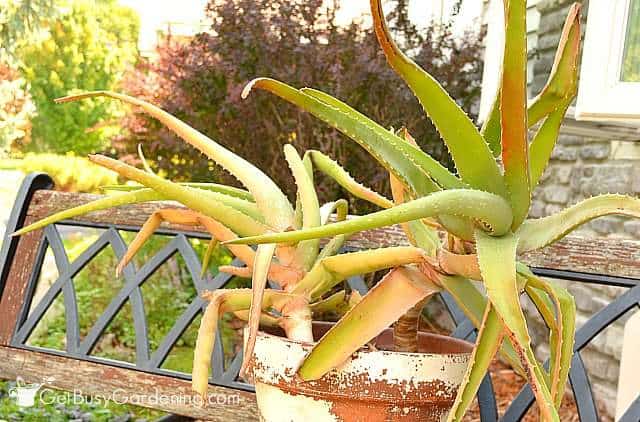
Light
Though they will tolerate partial shade outdoors, aloe vera grows best in a full sun location. If it gets enough sunlight, the leaves can turn a lovely shade of pink, and tall, yellow flower spikes will form.
On the other hand, if they don’t get enough, the plant will become tall and leggy over time. This can be a challenge indoors, so put it in a sunny south-facing window. If your home is too dark, then you should definitely get a grow light.
Related Post: How To Make DIY Aloe Vera Gel At Home
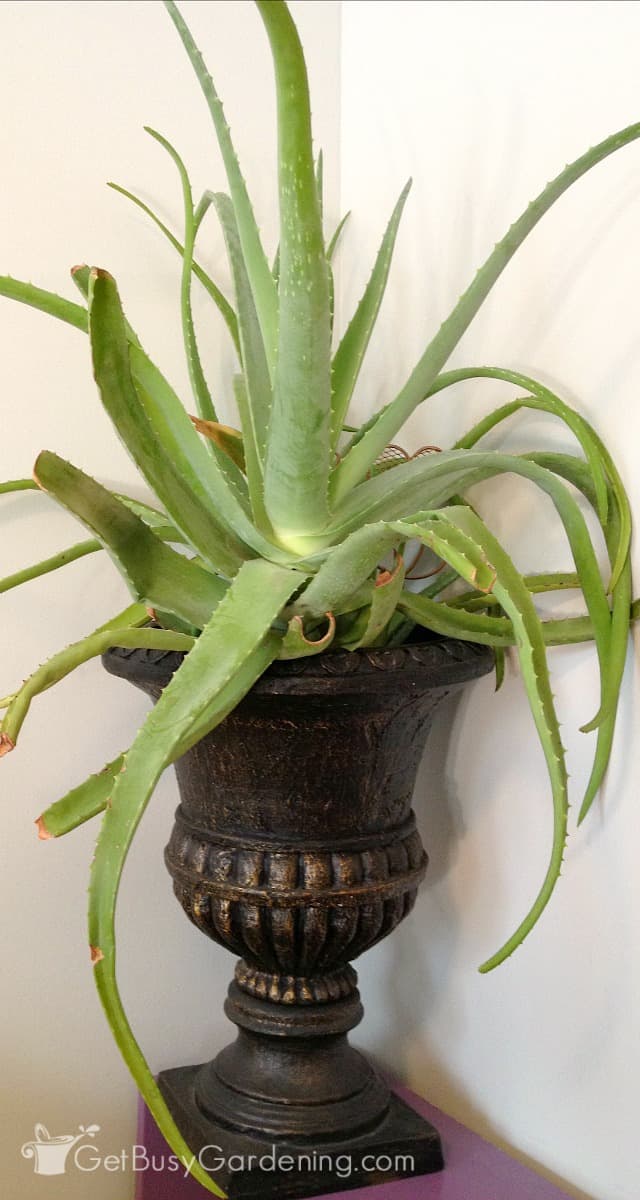
Soil
The best soil for aloe vera is a loose medium that drains very quickly. Use a sandy potting soil, or you could try a gritty mix if you tend to overwater.
I like to make my own, using a mix of perlite or pumice, coarse sand, and regular potting soil, which tends to be cheaper than buying the commercial stuff.
Related Post: How To Make Your Own Succulent Soil (With Recipe)
Repotting
The good news is that you won’t need to repot your plant very often, they like to be root-bound. When the time comes, use a container with drainage holes in the bottom, and only go up one or two sizes.
Planters made out of unsealed terracotta or clay are the best for growing aloe vera, and will wick water out of the soil, helping it dry out faster. Get my step by step instructions for how to repot your aloe vera plant here.
Fertilizer
Aloe vera plants don’t really need to be fertilized. But it will help encourage faster growth and blooming. I recommend using organic products rather than chemicals, especially if you plan to harvest the gel.
Apply a general purpose liquid monthly, or top-dress with slow-release granules once or twice during spring and summer.
Aloes go into a state of dormancy in the winter, and will hardly grow at all. So, don’t feed your plant during the fall and winter months to let them rest.
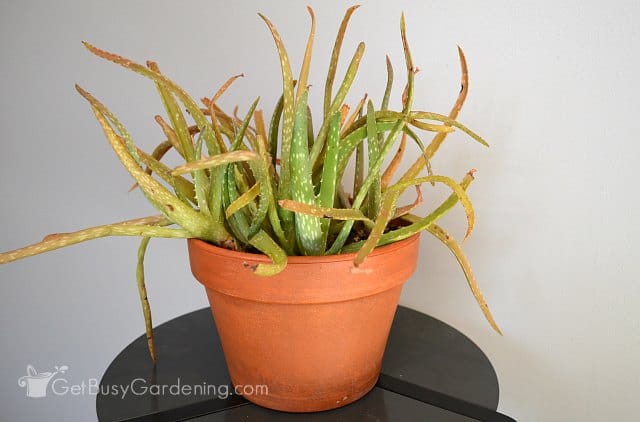
Pest Control Tips
Healthy aloe vera plants rarely have issues with insect pests, but sometimes mealybugs or scale can become a problem.
For small infestations, use a cotton swab soaked in rubbing alcohol to remove any visible bugs. For larger outbreaks, treat your plant with neem oil or an insecticidal soap.
But aloes can be sensitive to certain sprays. So, be sure to test anything you use on a small part of a leaf before treating the whole plant.
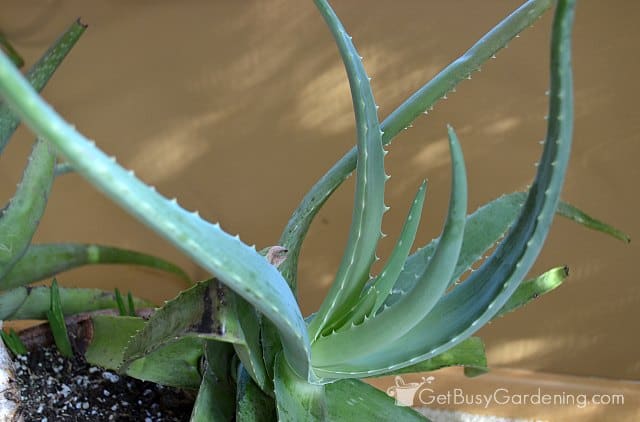
Propagating Your Aloe Vera
It’s easiest to propagate aloe vera plants by division. But if your plant has gotten very long and leggy, and you’re feeling brave, you could try rooting the stem cutting.
This technique can be much more difficult, but it’s fun to try. Simply let the wound cure (dry out) for several days so it calluses over. Then dust it with rooting hormone, and stick it in a dry, sandy medium.
Get my full step-by-step instructions for how to propagate aloe vera by division here.
Troubleshooting Aloe Vera Care Common Problems
Though aloe vera is usually pretty easy to care for, at some point you might start having issues with it. Below are a few of the most common problems, and what to do about them.
Plant Is Tall & Leggy
When an aloe vera grows tall and leggy, that means it’s not getting enough light. They do best with at least 6 hours of full sun per day. If yours is indoors, move it to a south-facing window, or add a grow light.
Mushy Stem
If the stem is completely mushy, that means it was overwatered at some point, and now it’s rotting at the base. Unfortunately there’s not much you can do to fix it.
But you can try saving your plant by cutting it off just above the mushy stem section and rooting it. Make sure you cut off all of the rot though, or it will continue to spread.
Brown Leaves Or Tips
If the brown leaves are drying out and shriveling up, that usually means your aloe vera is not getting enough water. In that case, you can just prune off the dead leaves and water it a little more often.
But if the leaves are mushy and brown, then it’s probably from too much moisture or humidity. So check the soil to make sure it’s not wet, then slow down on watering.
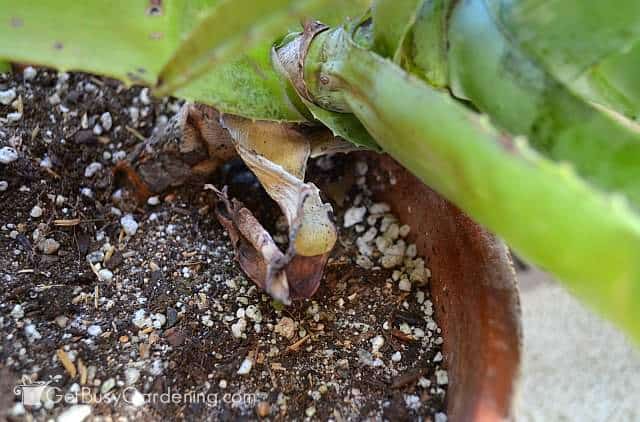
FAQs
Aloe veras can grow pretty fast outdoors in the right climate, but are much slower indoors. If you want yours to grow faster, try putting it outside during the summer, and give it some organic fertilizer.
Leaving the brown tips on your aloe vera won’t hurt the plant. But you can prune them off at any time if you don’t like the way they look.
A healthy aloe vera plant has thick, firm leaves that stand up tall and form tight rosettes. They should also be blueish-green in color (though it’s normal for the leaves to turn yellowish, pink, or orange in the full sun).
Caring for aloe vera is very low-maintenance because these tough plants thrive on neglect. Once you get the hang of giving it exactly what it needs, your plant will thrive for decades to come.
If you want to learn all there is to know about maintaining healthy indoor plants, then you need my Houseplant Care eBook. It will show you everything you need to know about how to keep every plant in your home thriving. Download your copy now!
Share your aloe vera plant care and growing tips in the comments section below.
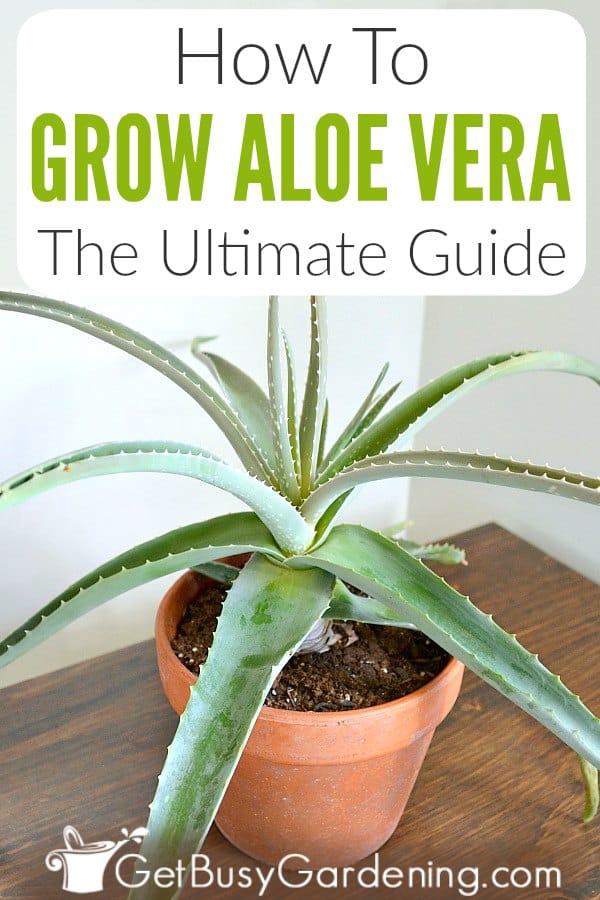
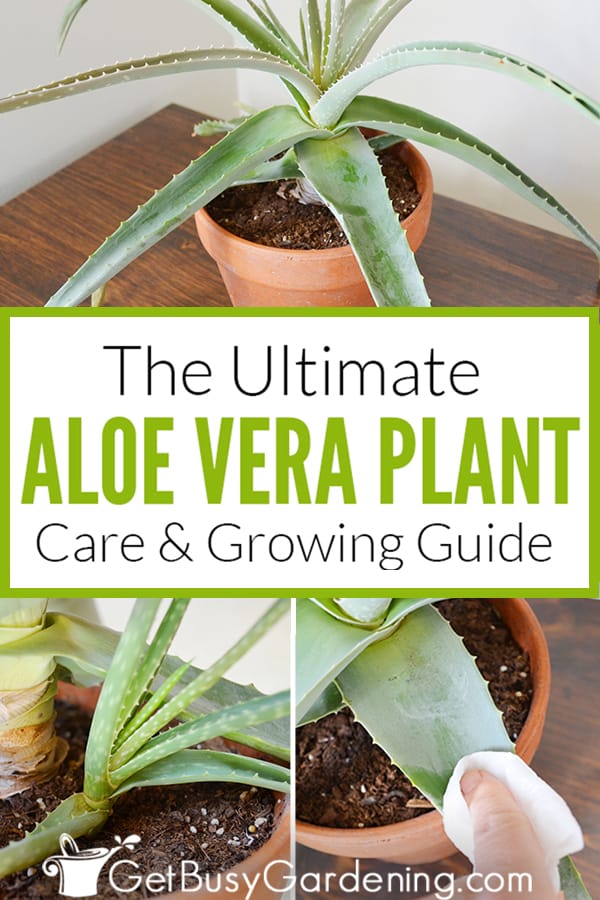
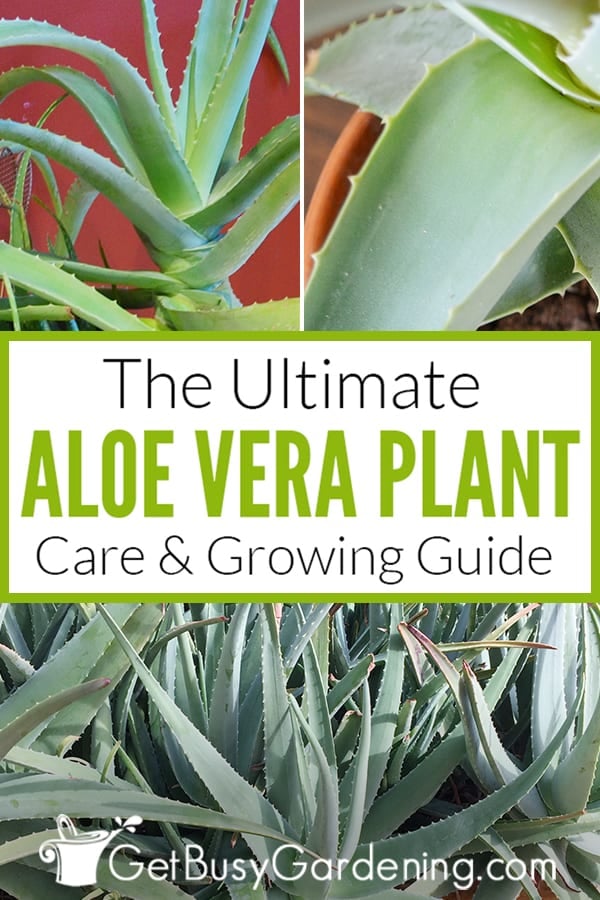
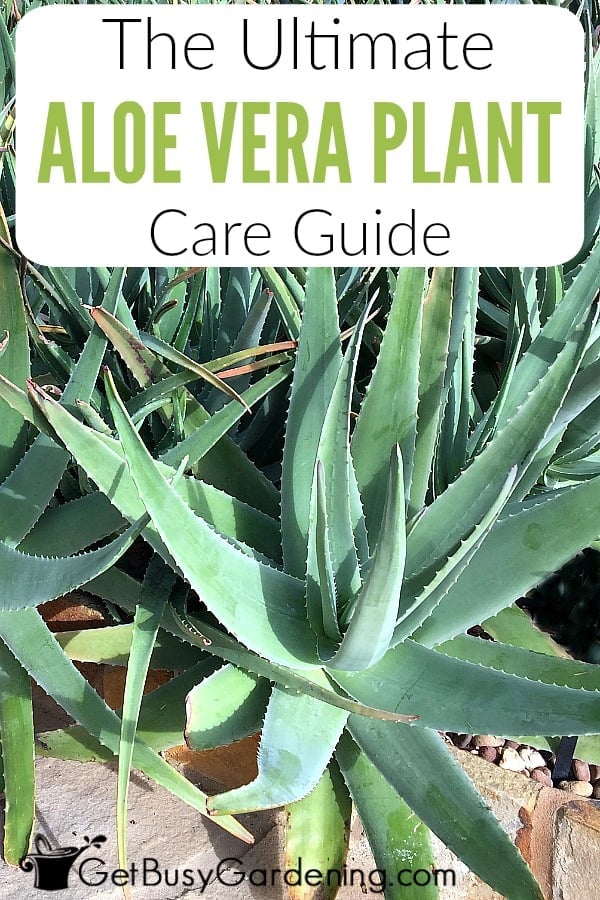
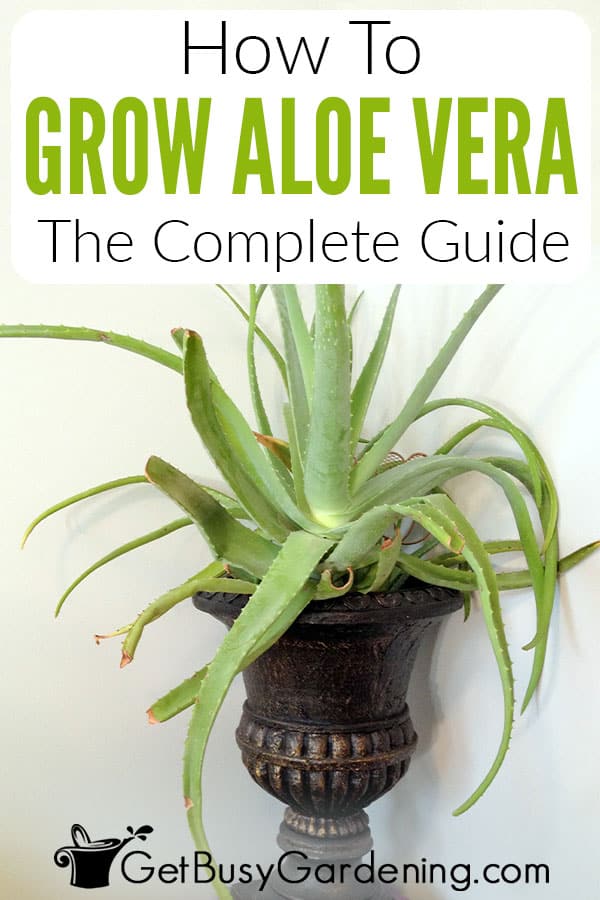
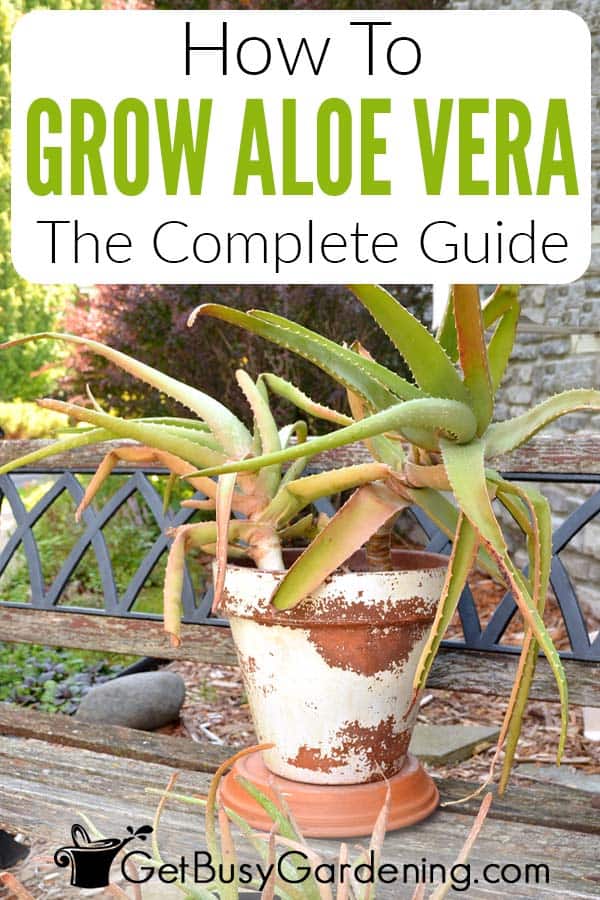
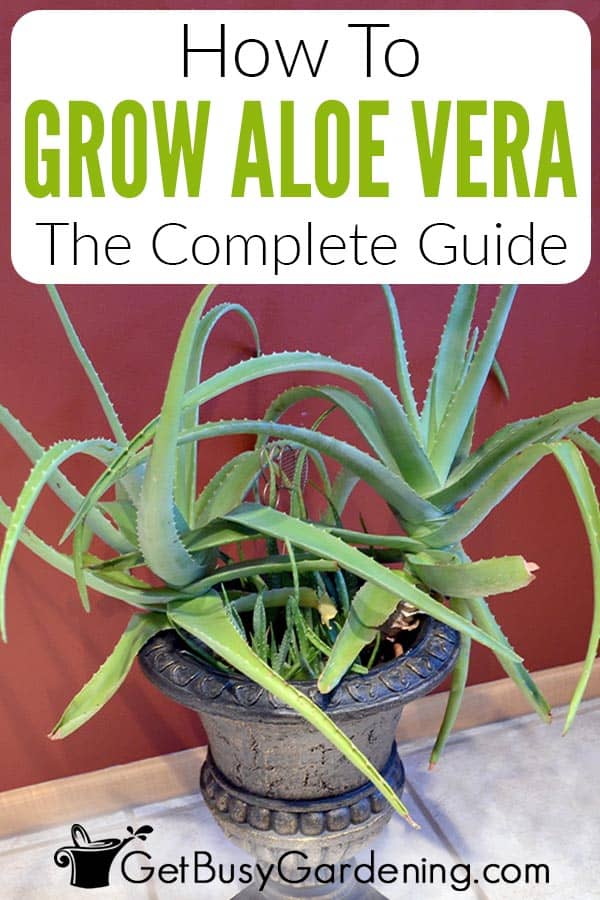
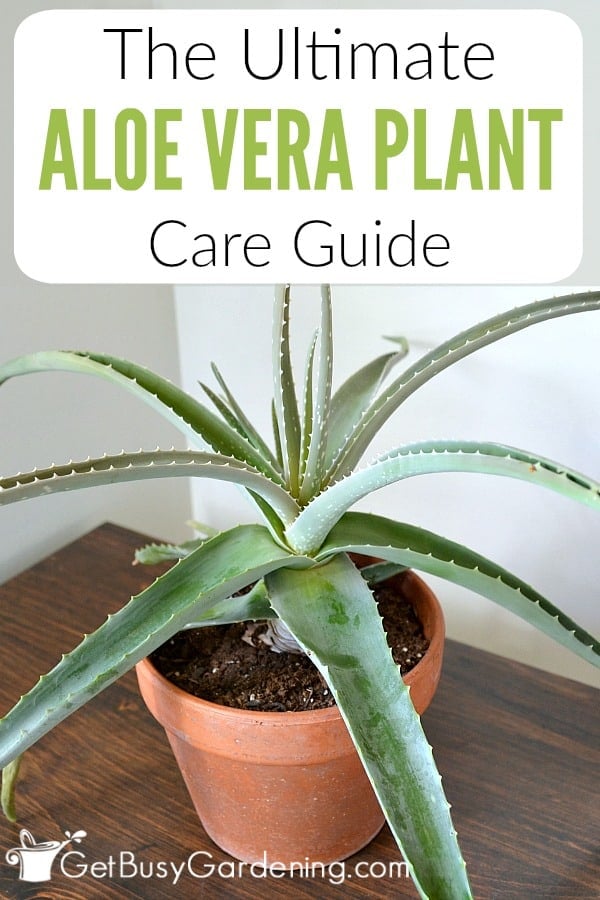
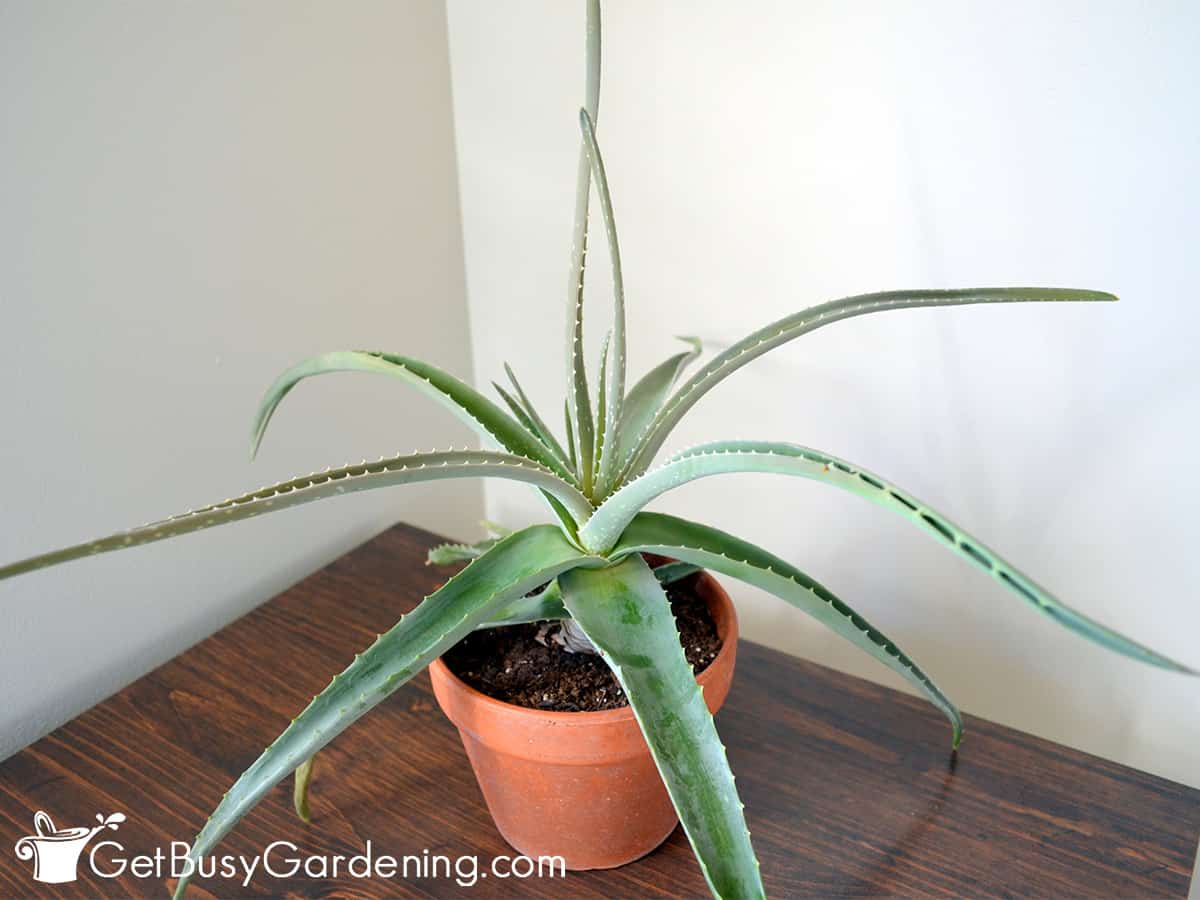




Bea Gomez says
Hi! I bought an aloe vera plant around 3 months ago, and have harvested 2 leaves since. I’ve been careful not to overwater it and keep it in a sunny area with enough shade, but so far there hasn’t been much growth from the buds growing at the top of the plant. I was wondering if I should re-pot it or move it indoors. What should I do?
Amy Andrychowicz says
Aloe veras aren’t super fast growing plants, so I don’t think you need to be worried. It sounds like you’re doing everything right. They can take full sun, as long as you introduce them to it slowly so they don’t burn. So, you could try moving it to a sunnier location.
Lanie Arndt says
I offered some friends pups off my huge outdoor aloe plants. Someone stated i had better make sure its the ‘right’ kind if plant before someone rubd it on their body. Is there a ‘wrong’ type of aloe plant and how does it differ?
Amy Andrychowicz says
Yes, your friend is right. There are tons of different varieties of aloe plants, and aloe vera is just one of them – and the only one with medicinal gel.
Cindy McDaniel says
Thanks so much for the tips, I have two aloe plants, one is huge, the other is still small, but growing like crazy ! I have shelves in my kitchen window with fluorescent bulbs over them, so plants left there do excellent ! I even found these cute little sayings to write on the pots, with a sharpie, I found it on Pinterest. Now, I just took them outside because it’s already getting hot here in Georgia, and before you know it it will be hot, humid, and miserable for humans, but not aloe plants, lol, they love it, of course. I wrote “ Aloe, is it me you’re looking for ? “ on one, and “ you had me at aloe” on the other ?
Amy Andrychowicz says
LOL, I love it!! What a cute idea for decorating your aloe pots. 😀
Maci Lawrence says
Thank you for the information! I do have a question.
I received a plant that’s already grown but in the process of him dropping it off and me picking it up there was a random patch of cold weather (25-35 F). The plant looks very droopy and folded, do you think it is able to perk back up or is it done for?
Amy Andrychowicz says
Oh no, sorry to hear your aloe was exposed to the cold like that! Check the leaves and see if they are mushy. You can prune off any damaged/mushy leaves and leave the healthy, firm ones. But even if the entire plant is mushy and seems to be a goner, don’t toss it out. It may grow back from the base with time.
David says
I got a aloe vera plant from local shop that got it from Holland, I want to eat it but a lealet on it said not for consumption,
Amy Andrychowicz says
Sorry but I really don’t know anything about eating aloe vera. I have seen it as an ingredient in several juice and food products, but I have no idea how to properly prepare it. I definitely would not eat the leaves straight from the plant. I would think they would taste terrible anyway.
Austin says
Hi, Amy! So I’ve been growing my aloe since last summer, they were gifted to me and fairly mature. I grew them on my pretty sunny front porch and they THRIVED, even flowered, and grew pups like crazy. During the winter, I brought them inside my house and have only recently put them back outside, in exactly the same spot they were before. Unfortunately, ever since I put them back outside, they’ve been turning red/brown and getting black spots. I also removed all the pups and repotted them, but I used a couple of bags of soil I had on hand from last fall and watered them as soon as they were in their pots. They look awful! I’ve gotten a lot of mixed opinions on when I should’ve watered them and I’m so confused. Do you think there’s any hope? Should I buy fresh soil and try again? I’m even considering buying some succulent liquid fertilizer to see if that helps. Currently moved them to the side of my house where it’s a bit shadier, but any advice would be appreciated! Poured so much love into them the last year, don’t want to lose them.
Amy Andrychowicz says
Sorry to hear your aloe plant is struggling! If you moved it directly from the house onto the sunny porch, then that could be the problem. Just like humans, plants that aren’t used to being in the full sun can get sunburn. So, leave your aloe in the shadier spot you mentioned, and give it some time to get used to being outside again before moving it. Then slowly introduce it back to it’s full sun location over the period of a few weeks (gradually giving it more sun every few days). If you start to see signs of sunburn again, move it back to shade and give it more time. As for the soil, just make sure you’re not overwatering it and that the soil is drying out between waterings. I definitely wouldn’t fertilize it until it recovers.
Sana says
Hii Amy,
Thank you so much for this helpful information, it is very helpful information.I will follow your tips, hope my Aloe will nicely grow…
Amy Andrychowicz says
You’re welcome! I hope your aloe will grow a thrive for years to come.
Sara Kimball says
First of all, love all your advice and thank you!!! My question is….should I not put an aloe in water beads as they release H2O as needed? Thank you can’t wait to hear your comment.
Amy Andrychowicz says
Humm… sorry but I don’t understand the question, could you rephrase?
Charlene says
The water beads are still wet. I’m not sure if that would cause the roots to rot?
Jeff Daniel says
I’ve been growing my aloe vera in a large pot and it is a decent 45 cm plant. it got pops and everything. do I stick with what I am doing or they what you are doing.
Thanks,
Jeff
Amy Andrychowicz says
Definitely stick with whatever’s working for you! 🙂
Amy says
I want to start growing an Aloe plant! What are some good tips/ suggestions before I get started? 🙂
Amy Andrychowicz says
You’ll find everything you need to know about growing an aloe vera plant if you read this guide. 🙂 Let me know if you have any specific questions.
Annette says
I want to know how to start a plant from a large leaf. My plants are so huge that the leaves are bending and breaking. Please tell me how to start a plant from a leaf or stem
Amy Andrychowicz says
Aloe veras can’t be propagated from leaf cuttings, but you can take stem cuttings. Read more about how to propagate them from stem cuttings in the section “Propagating Aloe Vera Plants” above.
Kim says
If plant was frozen from being outside…can it be saved?
Amy Andrychowicz says
Aloe vera is hardy down to about 20F. So, depending on how cold it got, you may still be able to save the plant.
Lucy says
Hi Amy,
Really good article and so informative! I have an aloe vera plant which was doing really well but seems to be a bit sad now and wondered where I’m going wrong? Some of the leaves are drooping slightly and as a result are lacking gel in places. Also, any ‘babies’ that are produced don’t seem to do very well from the get go and don’t really develop – I’ve re-potted one which has remained the same size for a while now and the leaves don’t feel developed at all really. I’ve also got another sprouting between the larger ones and that’s the same already.
It sounds like I’ve re-potted the larger plant in to a pot too big for it as well, as you mentioned that they don’t require too much room, so I think I’ll need to down size! Any tips on how to make my plant thrive as I’m kind of known to send them to their deaths (not on purpose of course!) I live in a small flat in England and have no garden so have indoor plants. My front room gets all the sun, which is where my aloe plant is, obviously though sun is limited for me! I’m still very hopeful and my plant doesn’t show signs of rot or anything like that so think it can be saved! You said that the leaves should be full but mine are starting to grow long and thin…Any help would be much appreciated! On the plus side – my spider plant is growing like crazy and I’ve been able to pot 2 babies up to now! I also have a peace lily in the bathroom as I hear they like steam…I’ll have a mooch through your page now to grab some tips on that one as well 🙂 Thanks in advance and sorry for the complete novice language in the world of plants…I’m determined to become green fingered for when I get a house!
Amy Andrychowicz says
Hi Lucy, Thanks, glad you liked the article! I wonder how often you’re watering your aloe vera plant. If the leaves aren thin then you might not be giving it enough water. It’s good to keep it on the dry side through the winter, but they can be watered more often during the summer months. I don’t water my large aloe plant at all during the winter, but the smaller ones get watered about once every month or two (once the soil has dried out between waterings). You could also try putting your aloe outside during the summer, they love that. I put mine out every summer and it grows huge and thick leaves. Just be sure they’re in a pot that has draining holes and fast draining soil if you put them outside.
Scot says
Can you give guidance with roughly how much cc to water small alor,just right where the stem is or everywhere, the plants are indoor now in winter in the UK, thanks.
Amy Andrychowicz says
I’d love to help, but I don’t understand your question. Could you rephrase it?
Scot says
Apology for the blunt wording.
Each time when i have to water the alor, about how much of water by milliliter per pot? and where should i pour the water? Around where the stem is or everywhere on the pot?
Thank you.
Amy Andrychowicz says
Simply pour water over the top of the soil until the soil is covered, or until water starts to run out the bottom of the pot. But, be sure that the soil is completely dry before watering your aloe vera plant.
Amanda says
Does the Aloe have any companion plants that I can put in the same pot?
Amy Andrychowicz says
You can grow any other type of succulent plant in the same pot as your aloe vera. A small aloe vera plant would be super cute in a DIY indoor succulent garden. 🙂
Michele H. says
Hi! I just moved into a new home and put my aloe facing a window but not directly in front of it, and I watered it as usual, once every few weeks, but now it has become droopy and the leaves are soft and mushy. I’m worried I overwatered it and it’s rotting but I also don’t know if it just wasn’t getting enough sun, so I moved it directly in front of a window to be safe. What do you think the problem is?
Amy Andrychowicz says
Uh oh, it sure does sound like your aloe plant has been overwatered. Lack of sun wouldn’t cause the leaves to be mushy. Unfortunately, I don’t you will be able to save the plant if all of the leaves are completely mushy. Sorry! 🙁
Marie says
Don’t give up just yet. I overwatered my aloe plant last summer just after moving it outside (I live in the Midwest). It got all mushy and brown. I thought it was a goner. My husband suggested we just ignore it and let it dry out. It worked! My aloe came back and grew like crazy by the end of summer! Now my pot is overrun with the main plant and a ton of offshoots…So many I don’t know what to do with them all. Don’t give up on your aloe just yet.
Amy Andrychowicz says
Woohoo! I love that story! Thanks for sharing.
Rachael Chinagorom says
Thanks Amy for the wonderful information. I think I will love to give it a try, will plant mine soonest
Amy Andrychowicz says
You’re welcome!